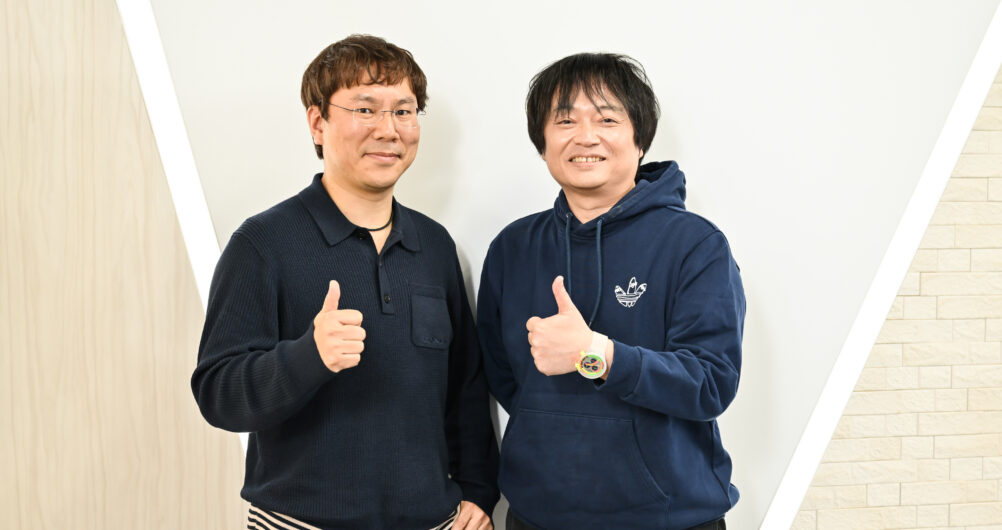Hiroyuki Kobayashi & Game Producers Interview Part 3
Hiroyuki Kobayashi sits down for the third installment of this interview series with industry-leading creators. This time, his conversation partner is Katsura Hashino, a game creator from Atlus. They discussed their respective approaches to game development, the latest works they’ve been involved in, and various behind-the-scenes episodes about ongoing projects.
Hiroyuki Kobayashi
GPTRACK50 President
At Capcom, has been involved in many popular series such as “Resident Evil” and “Sengoku BASARA”.
In 2022, established the game studio “GPTRACK50” and is currently developing a completely new title.
Katsura Hashino
ATLUS Creative Producer Game Director
He has directed and produced numerous titles, including the Persona series.
In the new RPG Metaphor: ReFantazio, he serves as the director.
Opinions on Producers and Directors
Sharing their personal perspectives on each other’s roles
Kobayashi: I believe the first time we met was at a game event held in Akihabara. That was over 10 years ago, before Persona 5 was released. We greeted each other at the event, had dinner together afterward, and since then, we’ve maintained a personal relationship. But we’ve never actually worked together on a project, have we?
Hashino: To me, Kobayashi-san is quite a unique individual. I was really inspired by the titles you worked on during your time at Capcom, like Sengoku BASARA and Devil May Cry. I had the impression of you as someone full of energy, always doing something exciting. Then, when I met you in person, I was surprised again to see how much experience and knowledge you had accumulated over the years. Even now, every time I meet you, I learn something new.
Kobayashi: I had the impression that you, Hashino-san, are an amazing creator who both produces and directs the Persona series. Persona is also actively expanding beyond games into areas like anime and stage productions. Since I’ve been trying similar cross-media initiatives for the titles I’ve worked on, I’ve exchanged information with you and drawn inspiration. By the way, for your latest title, Metaphor: ReFantazio, you’re just directing, right?
Hashino: Partway through development, someone took on the budgeting role, so I’m officially listed as the director. But in reality, I’m also handling producer duties. I still wanted to take full responsibility for the creative aspects until the end so. Kobayashi-san, you focus solely on producing, but I feel like our approaches to projects aren’t all that different. What do you think?
Kobayashi: I agree. Our basic attitudes are similar, but I adjust how much I get involved depending on the director I’m working with. For example, if the director excels at visuals, I leave the design aspects entirely to them. But if they’re not as strong in that area, I find and assign people who can support them. I let them push forward in their areas of expertise and help out where they struggle. The way I draw those lines differs for every title.
Hashino: You’ve never taken on the role of a director, right?
Kobayashi: No, I don’t. Because being a director is tough, isn’t it? (laughs) Directors have to progress the development step-by-step while having heated discussions with creators from all disciplines every day. That’s too much for me. Even as a producer, I talk with the creators, but being a director means those meetings become even more frequent, and the working relationships get much closer. I feel like you need to be tough to handle that. For me, it’s still easier to endure a weekly meeting where people say harsh things.
Hashino: I think producing sounds harder. As a director, you can focus on improving the game’s quality?that’s the sole axis of your work. But producers have to juggle company issues, adjust plans when unexpected changes arise, and deal with all sorts of things. Switching mental gears every time to resolve individual problems seems more difficult to me.
Kobayashi: That’s definitely a difference in our styles. There’s also another reason I don’t direct. I simply can’t compete with people who can create something out of nothing?those who can bring ideas to life from scratch, or “go from zero to one.” On the other hand, I have confidence in my ability to “take something from one to ten” based on logic and experience. I focus on producing because I feel I’m better suited to finding those people who can create something new and supporting them.
Hashino’s Approach to Writing Scenarios
A Glimpse into GPTRACK50’s New Project
Kobayashi: Since we’re here, I’d also like to ask about how you write scenarios. There are many elements involved?world-building, characters, and so on?but what do you prioritize when creating a scenario?
Hashino: The introduction and the ending. At the start of a story, there are usually a few characters, right? I first define their motivations and reasons for taking action. Once that’s roughly decided, I think about the ending. When the start and finish are clear, I then work on connecting them.
Kobayashi: That’s a unique approach?you don’t go step-by-step but rather start by solidifying the beginning and the end.
Hashino: By “ending,” I don’t mean writing the script at that point. I just think about the broad conclusion?like what conflicts occur and how they’re resolved. Once that’s decided, it’s easier to build the ups and downs in the middle. But with action games, it’s different, isn’t it? I once heard someone say, “You think about the various actions first?how to make them look fun?and then write a story to match them.”
Kobayashi: That’s largely true. We start with “this is the kind of gameplay we want to do” and then build the characters, world, and story.
Hashino: In that case, theoretically, you could finalize the game first and then write the scenario afterward, right?
Kobayashi: Technically, yes. But since we usually decide the scenario and world-building alongside character design, that rarely happens. Personally, I also prefer to finalize the scenario early on. For the current title we’re developing, I locked in the scenario fairly early. Having a scenario in place helps the development process move faster and reveals what’s missing.
Hashino: I don’t know much about it yet, but your current project is a story-driven game, right?
Kobayashi: Yes, it’s an action RPG with a proper story. Initially, I described it in interviews as an action game, but because it also includes growth elements, we redefined it as an action RPG. I didn’t want to make a game where only those with great skills could clear it. Even players who aren’t good at action can progress by growing their characters. That’s why we incorporated RPG elements and the fun of strategizing. To be precise, it’s more like an “action game with RPG elements to enjoy.”
Hashino: It’s GPTRACK50’s debut work and will become the studio’s flagship title, right?
Kobayashi: We’re aiming for a very edgy game, so I’m nervously overseeing its progress. But if it’s too edgy, that’s also a problem, so I’m keeping a close eye on the balance. When you were developing Metaphor, you challenged yourself to do things you couldn’t in the Persona series. Was there anything in particular that stood out to you?like new discoveries from taking on a fantasy setting?
Hashino: The decision to set Metaphor in a fantasy world was actually driven by strong requests from the staff. Personally, I focus on how to advance JRPGs to the next stage, not on any specific theme. But this time, because of the team’s requests and the suitability of a fantasy setting for our challenges, we built the game in this form. It wasn’t “let’s make a fantasy game” from the outset. If I make another game in the future and decide that the Sengoku era is the best setting, we might end up with a JRPG like Sengoku BASARA (laughs).
Exploring the Detail in the Anime Direction of Metaphor
Deep Diving into Atlus Development Team’s Passion
Kobayashi: I’d like to ask one more question about Metaphor. Following the Persona series, this title also features impressive animation direction. For you, Hashino-san, is animation an “essential element” that must be included in every project?
Hashino: Of course, even within the team, when the project initially started, there were voices saying, “Wouldn’t it be better not to use animation?” There were also proposals to construct all the scenes using CG cutscenes. However, the way animation works?depicting specific moments, breaking them up, and connecting them together?and the way CG works?adding motion to 3D models to show the sequence?are entirely different methods of expression. It’s not a matter of which is superior; for the JRPGs we create, the style of connecting key segments to build the whole narrative suited us better, which is why we incorporated animation into Metaphor.
Kobayashi: In the dialogue scenes, we see bust-up cuts of the characters in the foreground while the CG characters’ movements play in the background. From a producer’s perspective, this seems like double the effort and a massive workload. It feels like either one would be sufficient, but was this included to deepen players’ understanding of the characters and make them more emotionally connected?
Hashino: Yes, that’s exactly it. We determined that this style of direction is effective in leaving a strong impression of newly introduced characters or conveying emotionally significant moments. In fact, we’ve received a lot of positive feedback, so I’m glad we did it. And lastly, I’d like to ask you a question about your new project as well. It might be a bit early to ask, but since you’re to release the game, I assume you’re also aiming for a sequels or further development in the future, right?
Kobayashi: If the game sells well and is successful, I’d like to create a sequel. That said, it’s not good to think too far ahead, so for now, I’m focusing on making the first game as solid as possible. I have also told the development team, “Leave some room for a sequel.” If you define every setting too precisely, it becomes difficult to expand on it later. So I’ve made it clear: “You can decide on things, but keep the elements reflected in the game to a minimum.” That’s the mindset we’re working with right now. But if I may turn the question around, Hashino-san, aren’t you also thinking about turning Metaphor into a sequel?
Hashino: I do have various ideas, but at this point, it’s only been five weeks since the release (at the time of this interview), so we don’t have any concrete plans. However, I do hope that it develops that way. After all, this project started with the goal of creating a “third JRPG series” following Shin Megami Tensei and Persona. I want to nurture it into a flagship title that represents our company.



